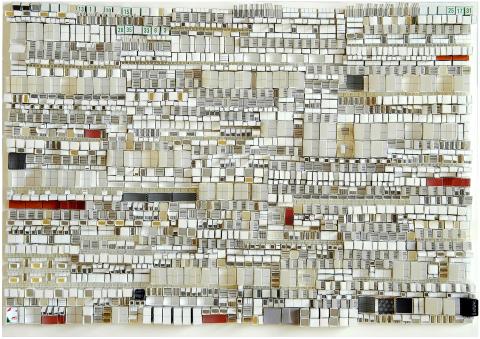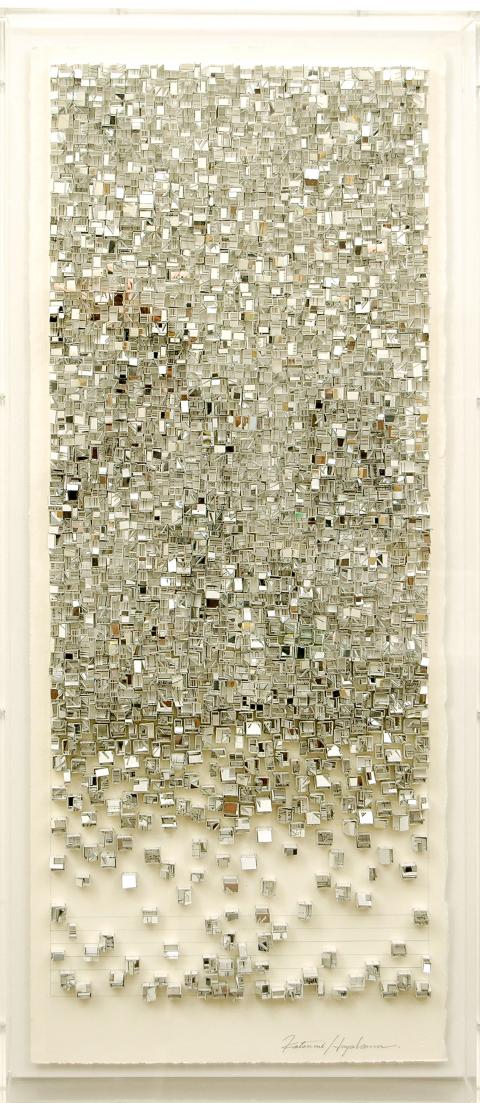Japanese artist Katsumi Hayakawa still recalls his reaction to Powers of Ten, a documentary he watched in junior high school that depicts, by positive and negative factors of 10, microcosmic and macrocosmic views of the known universe. The broad range of visual perspectives was, for Hayakawa, a revelation.
“I was shocked by what I saw,” he told the Taipei Times on Saturday. “You see the Earth, then the solar system, then the galaxy and then the universe and then it returns to the Earth and the camera shows [human] skin and then goes inside the body and becomes microscopic. It shows that what is outside and inside the human body are [interconnected].”
The documentary, written and directed by Charles and Ray Eames, who both made important contributions to contemporary architecture and design, “seems to contain the same ideas found in Buddhism,” Hayakawa said, referring to the notion that all phenomena are interconnected.

Photo courtesy of Nou Gallery
Hayakawa referenced the documentary to explain the ideas found in Urban Landscape, a series of 15 paper sculptures encased behind polymer casings and hung like paintings that are currently on view at Nou Gallery (新畫廊). Thankfully, knowledge of the universe or Buddhism isn’t required to enjoy them. The flat and built-up works ruminate on the visual similarities between electronic circuitry and urban environments, or the relation between simulated reality and concrete space.
Hayakawa, 40, is more commonly known for his geometric paintings in a style that could be called “virtual abstraction.” Tiny circles and squares in primary colors are linked by dark horizontal and vertical lines that make the works look like the inside of an integrated circuit. Each canvas contains several layers of paint that are etched to create the illusion of depth.
But Hayakawa was dissatisfied with the medium’s inherent flatness, and so he decided two years ago to shift to sculpture — a move, he said, that was initially fraught with difficulty because it received little support from galleries.

Photo courtesy of Nou Gallery
“They told me that [paper] is hard to preserve and therefore difficult to sell,” he says.
Three formative sculptures made last year hang at the back of the gallery, and this reviewer suggests viewers look at them before moving to the front to see the 12 works made this year. Two of these sculptures, Hakamono — Box 1 and Composition 3, are of particular interest because they serve as a kind of blueprint for the rest of the sculptures on display.
Hayakawa’s non-representational sculptures are built up using cubes or squares that he pastes onto watercolor paper. Hakamono — Box 1 (2010) is a single layer of these variously sized cubes pasted onto paper. The simple design and neatly arranged rows give the cubes and squares the appearance of capsule hotels or coffin-sized apartments, both features of Japan’s densely populated urban centers.
Whereas Hakamono — Box 1 uses cubes as its primary design element, the larger Composition 3 (2010) presents several vertiginous layers of square frames that grow more and more complex. It looks like scaffolding that has collapsed and then been randomly pieced back together. The arbitrary, almost erratic, profusion of shapes jutting out from the surface forces the eyes to continually search in vain for a place to fix on — perhaps a metaphor for our information-overloaded times.
Hayakawa’s 2011 sculptures are refined versions of his earlier creations. Traffic is similar to Composition 3, though the large blank spaces at the bottom of the canvas, revealing traditional Japanese paper, offer some visual respite. Traffic — Blue Lines does the same, and gives us a sense of Hayakawa’s influences with its Mondrian-inspired visual language and high-tech building design, which reminded me of France’s Pompidou Center.
Many of the other 2011 works appear to be trial models for as yet uncreated works. Reflection 3 is an assemblage of tiny, mirrored cubes that focus on line and reflection and the blurring of the two. Transcolor 2, with its colored lines discernable through a matrix of rectangles, experiments with holography, depth perception and the illusion of space.
The fact that Hayakawa has focused his artistic attention on sculpture for only a few years lends many of these works the appearance of sculptural experiments, which translates, for this reviewer, into incomplete artistic concepts. Still, Hayakawa is on to something here, and the fact that I can’t quite put my finger on exactly what shouldn’t discourage people from visiting the gallery to view his extremely original artwork.
Hayakawa has also designed a public art project with Nou Gallery, to be held throughout the exhibit period. Dubbed Create Dream City With Katsumi, visitors are invited to create their own “dream home” using Hayakawa’s trademark cubes and cutout squares. Each participant is given a square piece of watercolor paper on which they are directed to erect their sculpture. The works are then affixed to a large canvas, which hangs at the back of the gallery space.

Taiwan Power Co (Taipower, 台電) and the New Taipei City Government in May last year agreed to allow the activation of a spent fuel storage facility for the Jinshan Nuclear Power Plant in Shihmen District (石門). The deal ended eleven years of legal wrangling. According to the Taipower announcement, the city government engaged in repeated delays, failing to approve water and soil conservation plans. Taipower said at the time that plans for another dry storage facility for the Guosheng Nuclear Power Plant in New Taipei City’s Wanli District (萬里) remained stuck in legal limbo. Later that year an agreement was reached

What does the Taiwan People’s Party (TPP) in the Huang Kuo-chang (黃國昌) era stand for? What sets it apart from their allies, the Chinese Nationalist Party (KMT)? With some shifts in tone and emphasis, the KMT’s stances have not changed significantly since the late 2000s and the era of former president Ma Ying-jeou (馬英九). The Democratic Progressive Party’s (DPP) current platform formed in the mid-2010s under the guidance of Tsai Ing-wen (蔡英文), and current President William Lai (賴清德) campaigned on continuity. Though their ideological stances may be a bit stale, they have the advantage of being broadly understood by the voters.

In a high-rise office building in Taipei’s government district, the primary agency for maintaining links to Thailand’s 108 Yunnan villages — which are home to a population of around 200,000 descendants of the Chinese Nationalist Party (KMT) armies stranded in Thailand following the Chinese Civil War — is the Overseas Community Affairs Council (OCAC). Established in China in 1926, the OCAC was born of a mandate to support Chinese education, culture and economic development in far flung Chinese diaspora communities, which, especially in southeast Asia, had underwritten the military insurgencies against the Qing Dynasty that led to the founding of

It’s fairly well established that strength training is helpful at every age: as well as building muscle, it strengthens tendons and ligaments, increases bone density and seems to have protective effects against everything from osteoporosis to dementia. But a new study based on data collected over two decades in Rio de Janeiro, Brazil, suggests that another physical attribute might be just as important — and it’s one that declines even faster than strength as the years go by. The good news? It might also be less uncomfortable, and even slightly safer, to improve. Also, it will probably make you better